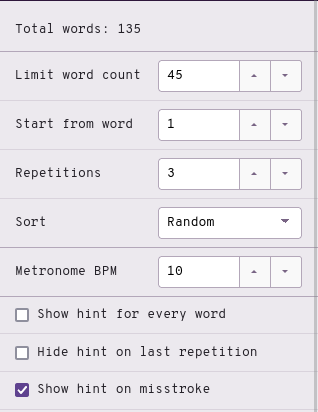Chapter 7: Vowels
Useful links
- Single syllable
OE,OU, andOEUwords drill - Single syllable
AEUwords drill - Single syllable
AOUwords drill - Chapter 7 test
Intro
Vowels are reportedly the most difficult part of learning steno. Part of this is due to the fact that vowels are pronounced differently in different dialects of English. Unfortunately, I grew up learning General American English. This is the accent that Lapwing is based on.
If you speak a different accent, you may have to subvocalize with an American accent (sorry).
I’m making an effort to include IPA with the hopes that they will be useful for some. However, I must make the disclaimer that I have never taken a formal linguistics course nor am I an enthusiast. I apologize for any errors that may be present in this page—do reach out to me if you have corrections!
OE, OU, and OEU
OEis the long o vowel as in “tote”- /oʊ/
Linguistically, calling this a long vowel is incorrect (this is actually a diphthong), but it’s what most people would be familiar with (see here).
OUis the “ow” sound as in “cow”- /aʊ/
OURis the sound as in “hour”- /aʊ ər/
OEUis the sound as in “toy”- /ɔɪ/
Examples
- foe
TPOE* - sow
SOE - foul
TPOUL* - power
POUR - coil
KOEUL - soy
SOEU
If you’re having trouble associating the
OEandOUchords, I suggest remembering the words marked with *.
Mnemonics
Feel free to come up with your own or even suggest some!
- The word “foe” is spelled with the letters
OE.- Apply this to other words with the same vowel sound!
- The word “our” is spelled with
OU. OEUcan be thought of asO+EUor “oi” which resembles its pronunciation and spelling (as in the word “soil”)
Section practice
Single syllable OE, OU, and OEU words drill
AEU
AEUis the long a vowel as in “pay”- /eɪ/
NOTE: be careful with words like “bag”, “tank”, and “sag”; these use
Afor /æ/ and notAEU. The difference is subtle, but try to convince yourself that these are different vowels.
AEURis the sound as in “pair”- /ɛr/
Examples
- day
TKAEU - lay
HRAEU - care
KAEUR - pair
PAEUR
Mnemonics
Feel free to come up with your own or even suggest some!
AEUcan be thought asA+EUor “ai” which resembles its pronunciation and spelling (as in the word “paid”)- If the notion of long vowels and short vowels (as described above) is familiar,
AEUcan be thought of as transforming theAkey into a long a by combining it with the two keys on the other side- Long a =
A+ (vowel keys on other hand)
- Long a =
Section practice
Single syllable AEU words drill
AOU
-
AOUrepresents two different sounds:- The long u sound as in “cube”
- /ju/
- The “oo” sound as in “glue”
- /u/
- Only when the sound is not spelled with “oo”
- E.g., “loo” would not use
AOU
- E.g., “loo” would not use
- The long u sound as in “cube”
-
AOURis the sound as in “cure”- /ʊər/
Examples
- ew
AOU - sue
SAOU - lure
HRAOUR - pure
PAOUR
Mnemonics
Feel free to come up with your own or even suggest some!
- If the notion of long vowels and short vowels (as described above) is familiar, the
AOUchord can be thought of as transforming theUkey into a long u by combining it with the two keys on the other side- Long u =
U+ (vowel keys on other hand)
- Long u =
- The long u sound is also quite similar to the “oo” sound
Section practice
Single syllable AOU words drill
Chapter 7 test
This chapter’s test consists of all the practice drills you have done in this chapter. Make sure your settings are configured as such:

- Limit word count: 45
- Start from word: 1
- Repetitions: 3
- Sort: random
- Show hint for every word: unchecked
- Hide hint on last repetition: unchecked
- Show hint on misstroke: checked
Click here to access the chapter 7 test
Recommended completion goal
This is only a suggestion if you are unsure of when to move on to the next chapter; it is not a strict requirement!
Aim for 5-20 WPM with 90% accuracy.
You may use the test material as practice!
Chapter briefs
This section is completely optional, but recommended. If you prefer to learn these all at once, they will be covered in chapter 16.
| Word | Brief | Explanation |
|---|---|---|
| a | AEU | Sounds like the letter “A” |
| can | K | Single key brief for a common word |
| for | TP-R | Drops the vowel |
| in | TPH | in |
| if | TP | if |
| new | TPHU | The proper long u TPHAOU vowel is reserved for the word “knew” |
| to | TO | Matches the spelling |
| two | TWO | Matches the spelling |
| , | KW-BG | Symmetrical shape like the period/full stop. |
| ! | TP-BG | Shape resembles a lowering intonation (not accurate to the exclamation mark, but contrasts with the question mark). |
NOTE: remember that these are briefs; the explanations are not applicable to any arbitrary word.
Practice sentences
- can you say two?
- I paid for a can!
- I got a new car in the house.
- if you trade, can I pay for the place?
Answers
K/U/SAEU/TWO/KW-PLEU/PAEUD/TP-R/AEU/K/TP-BGEU/TKPWOT/AEU/TPHU/KAR/TPH/-T/HOUS/TP-PLTP/U/TRAEUD/KW-BG/K/EU/PAEU/TP-R/-T/PHRAEUS/KW-PL
Extra briefs
| Brief | Outline | Explanation |
|---|---|---|
| for the | TP-RT | TP-R + -t |
| can you | KU | K + U |
| in the | TPH-T | TPH + -T |
| if the | TP-T | TP + -T |
| to the | TOT | TO + -T |